Characteristics of Small-Molecule Migration of Silicone Rubber Insulator in Electrical Power Systems
Abstract
:1. Introduction
2. Experimental Arrangement and Measurement Mothed
3. Experimental Results
3.1. Hydrophobicity Transfer of Inert Materials
3.2. Evidence of Small-Molecule Migration
3.3. Influence of Pollution Material Characteristics
4. Discussion
4.1. Solid Adsorption Theory
4.2. Equivalent Discussion of Natural and Artificial Pollution
5. Conclusions
- (1)
- The ten different inert materials analyzed in this study had different migration times and static contact angles. The hydrophobicity transfer process for kaolin-polluted HTV-SR surfaces was much slower than those polluted with kieselguhr under the same conditions (about 7 times slower). The final degree of hydrophobicity for kaolin-polluted HTV-SR surfaces (contact angle 75°) was much less than that for kieselguhr-polluted surfaces (contact angle 120°) under the same conditions (contact angle about 40% less).
- (2)
- Thermogravimetric analysis (TG), Fourier transform infrared spectroscopy (FTIR), and gas chromatography–mass spectrometry (GC–MS) were used to analyze the migration of small molecules to the polluted surface. The evidence of small molecules migrating to the surface of the pollution over time was found.
- (3)
- The microstructure of the pollutants influenced the hydrophobicity transfer characteristics of HTV-SR. Kieselguhr comprises a wide variety of siliceous diatom skeletons of different shapes and sizes. This loose structure inevitably has large voids between the diatom skeletons, which allow the swift migration of LMW components of polysiloxane through the kieselguhr material. In contrast, the similar flat-sheet-like crystals of kaolin stack together with fewer interstitial voids, resulting in slower hydrophobicity transfer.
- (4)
- Mixtures of kieselguhr and kaolin can be used to emulate natural pollutants in testing composite insulators. A rest period of one to four days is required before the test to complete the hydrophobicity transfer.
Author Contributions
Funding
Institutional Review Board Statement
Informed Consent Statement
Data Availability Statement
Conflicts of Interest
References
- Salem, A.A.; Lau, K.Y.; Rahiman, W.; Al-Gailani, S.A.; Abdul-Malek, Z.; Rahman, R.A.; Al-Ameri, S.M.; Sheikh, U.U. Pollution Flashover Characteristics of Coated Insulators under Different Profiles of Coating Damage. Coatings 2021, 11, 1194. [Google Scholar] [CrossRef]
- Ghayedi, M.; Shariatinasab, R.; Mirzaie, M. AC flashover dynamic theoretical and experimental model under fan-shaped and longitudinal pollution on silicone rubber insulator. IET Sci. Meas. Technol. 2021, 15, 719–729. [Google Scholar] [CrossRef]
- Chrzan, K.L.; Brzezinski, H.M. Anomalous flashovers of silicone rubber insulators under the artificial rain test. Arch. Electr. Eng. 2021, 70, 835–844. [Google Scholar]
- He, S.; Wang, J.; Hu, J.; Zhou, H.; Nguyen, H.; Luo, C.; Lin, J. Silicone rubber composites incorporating graphitic carbon nitride and modified by vinyl tri-methoxysilane. Polym. Test. 2019, 79, 106005. [Google Scholar] [CrossRef]
- Liao, Y.; Weng, Y.; Wang, J.; Zhou, H.; Lin, J.; He, S. Silicone Rubber Composites with High Breakdown Strength and Low Dielectric Loss Based on Polydopamine Coated Mica. Polymers 2019, 11, 2030. [Google Scholar] [CrossRef] [Green Version]
- Jin, L.; Ai, J.; Han, S.; Zhou, G. Probability Calculation of Pollution Flashover on Insulators and Analysis of Environmental Factors. IEEE Trans. Power Deliv. 2021, 36, 3714–3723. [Google Scholar] [CrossRef]
- Chang, J.W.; Gorur, R.S. Surface recovery of silicone rubber used for HV outdoor insulation. IEEE Trans. Dielectr. Electr. Insul. 1994, 1, 1039–1046. [Google Scholar] [CrossRef]
- Li, Z.; Yin, F.; Cao, B.; Wang, L.; Shao, S.; Farzaneh, M. Pollution flashover performance of RTV coatings with partial damage. Int. J. Electr. Power Energy Syst. 2020, 121, 106102. [Google Scholar] [CrossRef]
- Tahir, M.H.; Arshad, A.; Manzoor, H.U. Influence of corona discharge on the hydrophobic behaviour of nano/micro filler based silicone rubber insulators. Mater. Res. Express 2022, 9, 035302. [Google Scholar] [CrossRef]
- Khattab, T.A.; Mowafi, S.; El-Sayed, H. Development of mechanically durable hydrophobic lanolin/silicone rubber coating on viscose fibers. Cellulose 2019, 26, 9361–9371. [Google Scholar] [CrossRef]
- Mendoza, A.I.; Moriana, R.; Hillborg, H.; Strömberg, E. Super-hydrophobic zinc oxide/silicone rubber nanocomposite surfaces. Surf. Interfaces 2019, 14, 146–157. [Google Scholar] [CrossRef]
- Liu, H.; Cash, G.A.; Sovar, R.D.; George, G.A.; Birtwhistle, D. Studies of the diffusion of low molecular weight silicone fluids on polluted hv silicone insulators. I. use of diffuse reflectance FTIR. IEEE Trans. Dielectr. Electr. Insul. 2006, 13, 877–884. [Google Scholar] [CrossRef]
- Sakoda, T.; Tabira, K.; Miyake, T.; Hayashi, N.; Haji, K.; Aka, Y.; Fukano, T. Discharge behavior and dielectric performance of artificially polluted hydrophobic silicone rubber. J. Electrost. 2018, 93, 97–103. [Google Scholar] [CrossRef]
- Sarkarat, M.; Lanagan, M.; Ghosh, D.; Lottes, A.; Budd, K.; Rajagopalan, R. High field dielectric properties of clay filled silicone rubber composites. Mater. Today 2020, 23, 100947. [Google Scholar] [CrossRef]
- Myat Thu, A.; Song, M.; Wu, S.; Sheng, A.; Chen, X.; Wang, X. Artificial Neural Network Prediction and Mechanism Analysis for Migration of Environmental Contaminant Cyclic Organosiloxane Oligomer from Silicone Rubber. Ind. Eng. Chem. Res. 2019, 58, 11093–11100. [Google Scholar] [CrossRef]
- IEC 60507: 1991; Artificial Pollution Tests on High-Voltage Insulators to Be Used on a.c. Systems. ANSI: Washington, DC, USA, 1991.
- Yong, Z. Influence of corona discharge on hydrophobicity of silicone rubber used for outdoor insulation. Polym. Test. 2019, 74, 14–20. [Google Scholar]
- Kumar, V.; Lee, D.J. Effects of thinner on RTV silicone rubber nanocomposites reinforced with GR and CNTs. Polym. Adv. Technol. 2017, 28, 1842–1850. [Google Scholar] [CrossRef]
- Swift, D.A.; Spellman, C.; Haddad, A. Hydrophobicity Transfer from Silicone Rubber to Adhering Pollutants and its Effect on Insulator Performance. IEEE Trans. Dielectr. Electr. Insul. 2006, 13, 820–829. [Google Scholar] [CrossRef]
- IEC 62217: 2005; Polymeric Insulators for Indoor and Outdoor Use with Nominal Voltage > 1000 V. ANSI: Washington, DC, USA, 2005.
- IEC TS 62073: 2003; Guidance on the Measurement of Wettability of Insulator Surfaces. ANSI: Washington, DC, USA, 2003.
- Kumar, V.; Alam, M.N.; Manikkavel, A.; Song, M.; Lee, D.J.; Park, S.S. Silicone rubber composites reinforced by carbon nanofillers and their hybrids for various applications: A review. Polymers 2021, 13, 2322. [Google Scholar] [CrossRef] [PubMed]
- Cheng, Z.X.; Liang, X.D.; Zhou, Y.X.; Wang, S.W.; Guan, Z.C. Observation of corona and flashover on the surface of composite insulators. In Proceedings of the IEEE Power Tech Conference, Bologna, Italy, 23–26 June 2003; Volume 2, pp. 1–6. [Google Scholar]
- Lan, L.; Gorur, R.S. Computation of ac wet flashover voltage of ceramic and composite insulators. IEEE Trans. Dielectr. Electr. Insul. 2008, 15, 1346–1352. [Google Scholar] [CrossRef]
- Yongqing, Y.U. DC Contamination Flashover Performance of Composite Insulators Lost Hydrophobicity. Power Syst. Technol. 2006, 30, 12–15. [Google Scholar]
- Zhu, L.Y.; Sun, Y.L.; Chen, G.Y. Handbook of Instrument Analysis; Chemical Industry Press: Beijing, China, 1997. (In Chinese) [Google Scholar]
- Camino, G.; Lomakin, S.M.; Lazzari, M. Polydimethylsiloxane thermal degradation Part 1. Kinetic aspects. Polymer 2001, 42, 2395–2402. [Google Scholar] [CrossRef]
- Kim, S.H.; Chereny, E.A.; Hackam, R.; Rutheford, K.G. Chemical changes at the surface of RTV silicone rubber coatings on insulators during dry-band arcing. IEEE Trans. Dielectr. Electr. Insul. 1994, 1, 106–123. [Google Scholar]
- Kim, S.H.; Chemey, E.A.; Hackam, R. The loss and recovery of hydrophobicity of RTV silicone rubber insulator coatings. IEEE Trans. Power Deliv. 1990, 5, 1491–1500. [Google Scholar] [CrossRef]
- Yan, J.; Zhang, Q.; Gao, J. Adsorption and Coagulation; Science Press: Beijing, China, 1986. [Google Scholar]

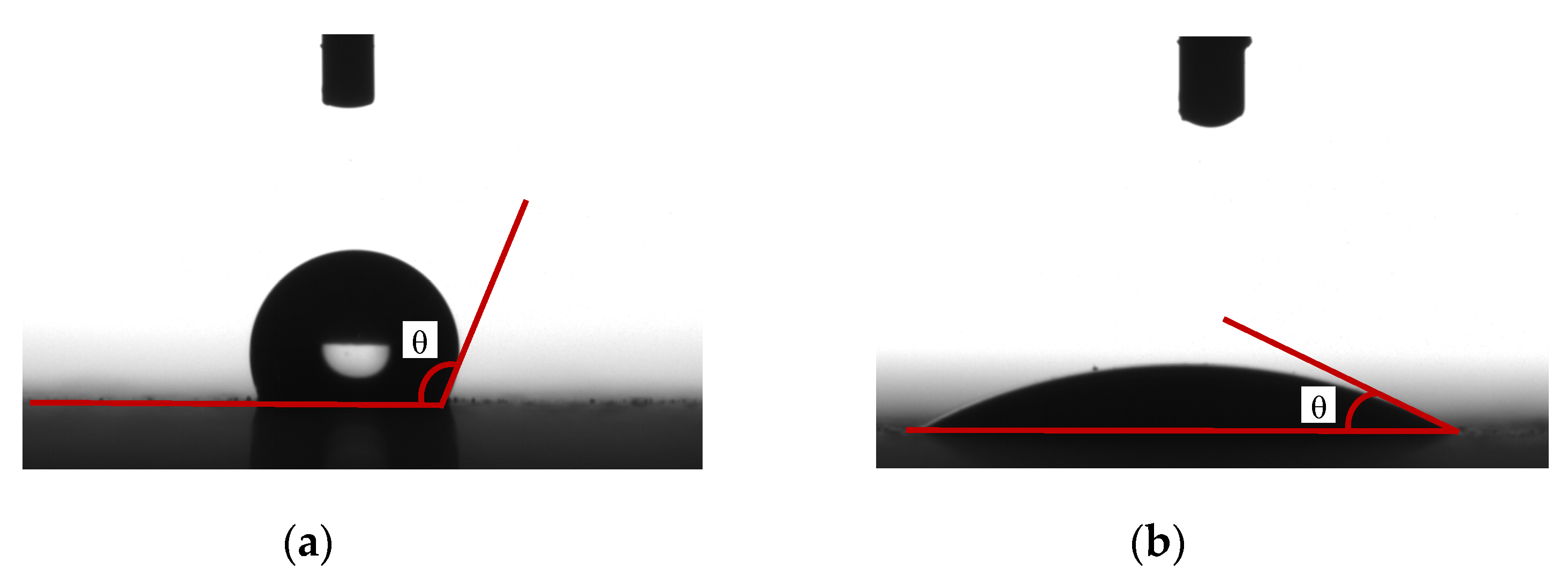

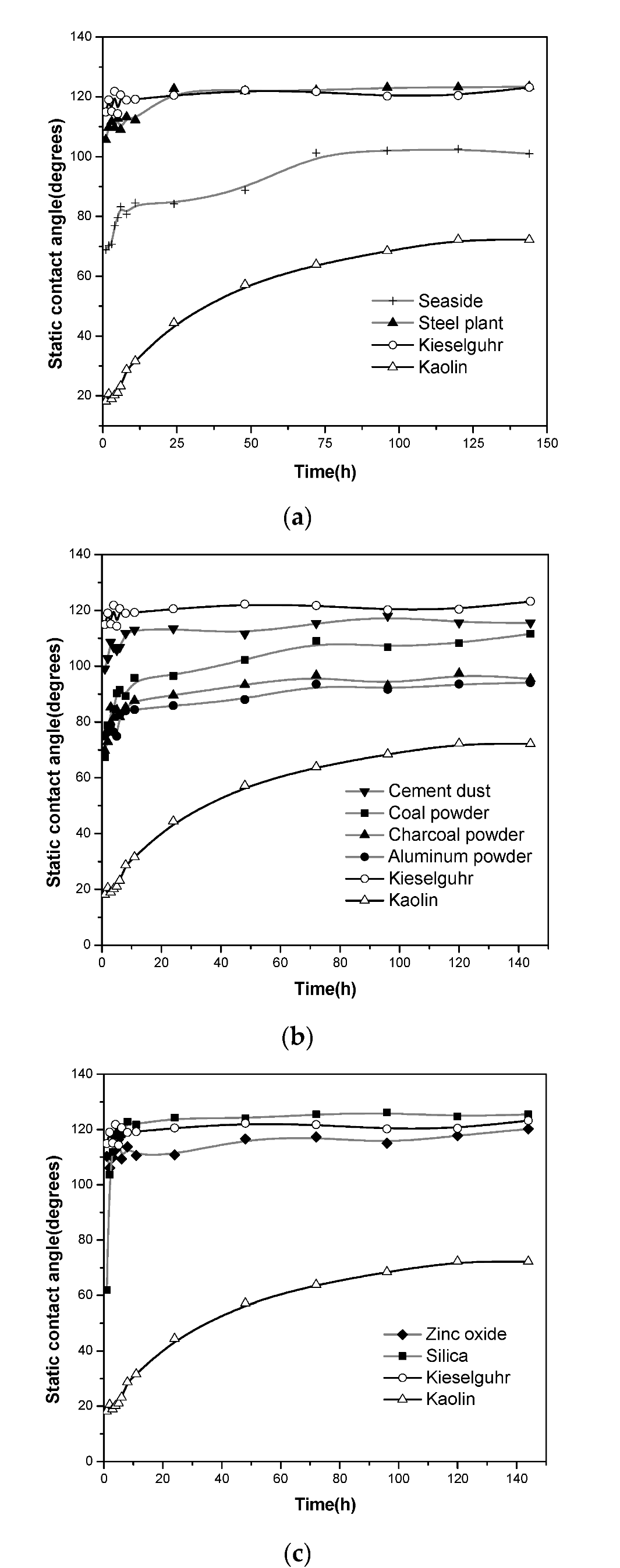
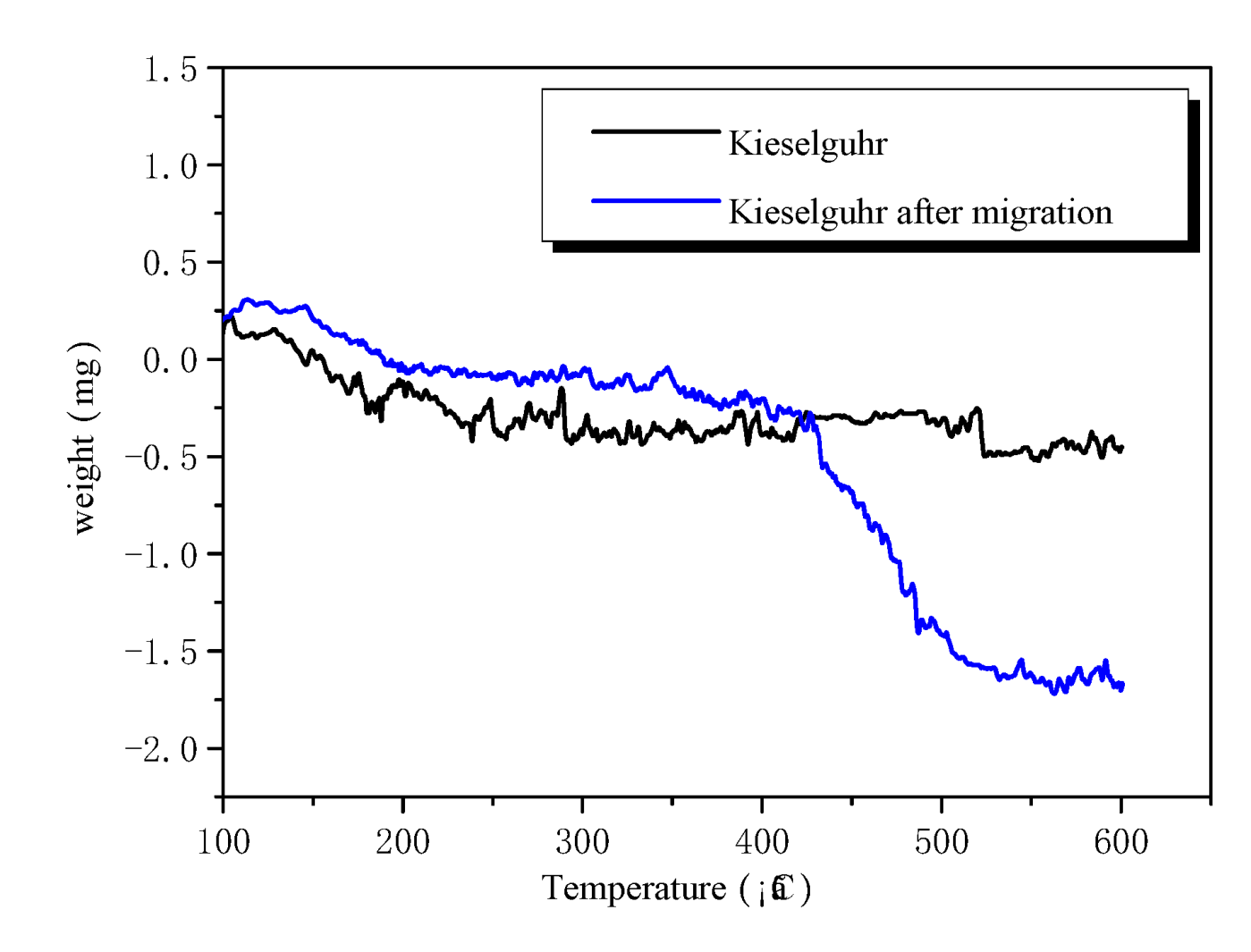

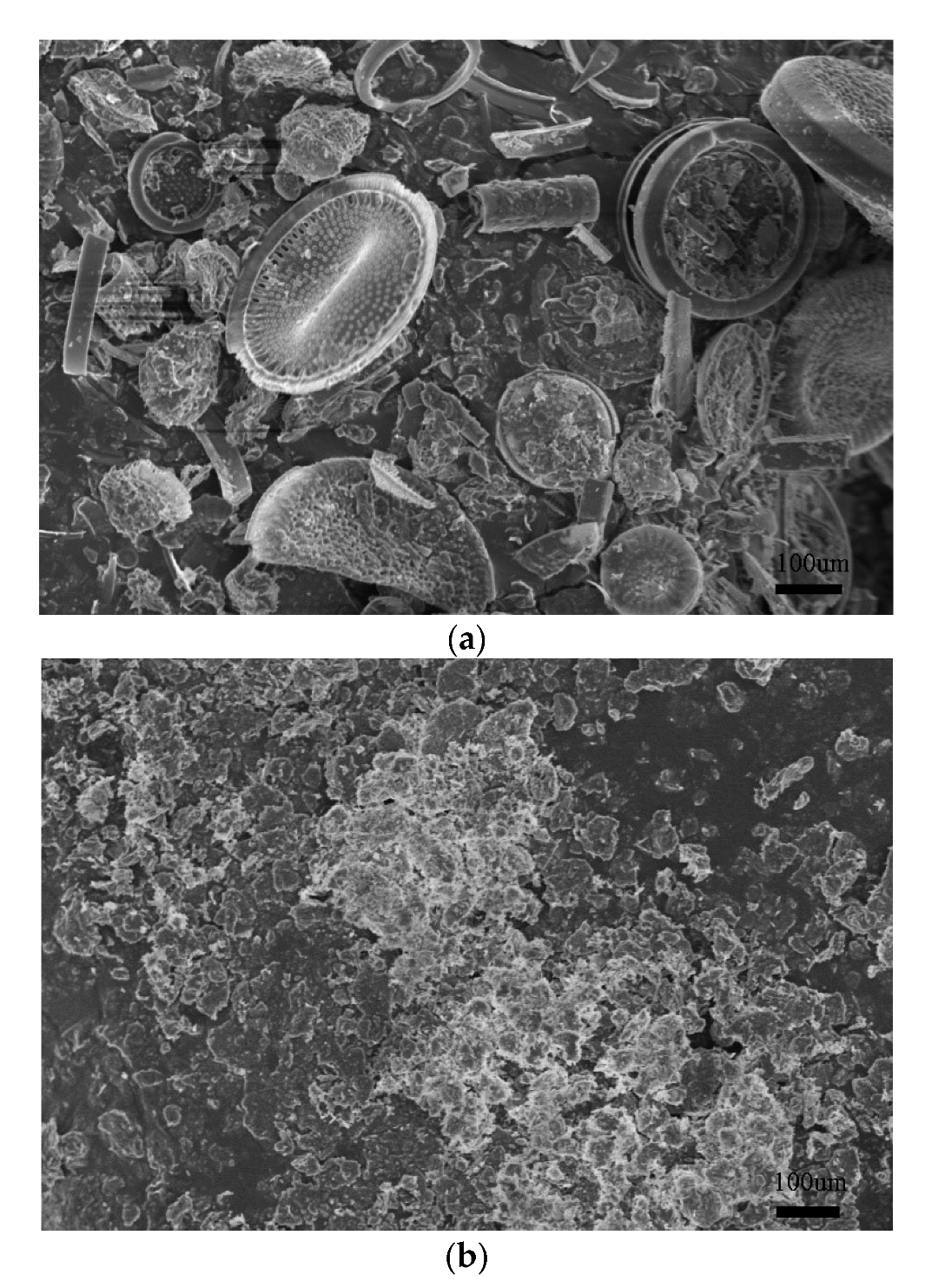
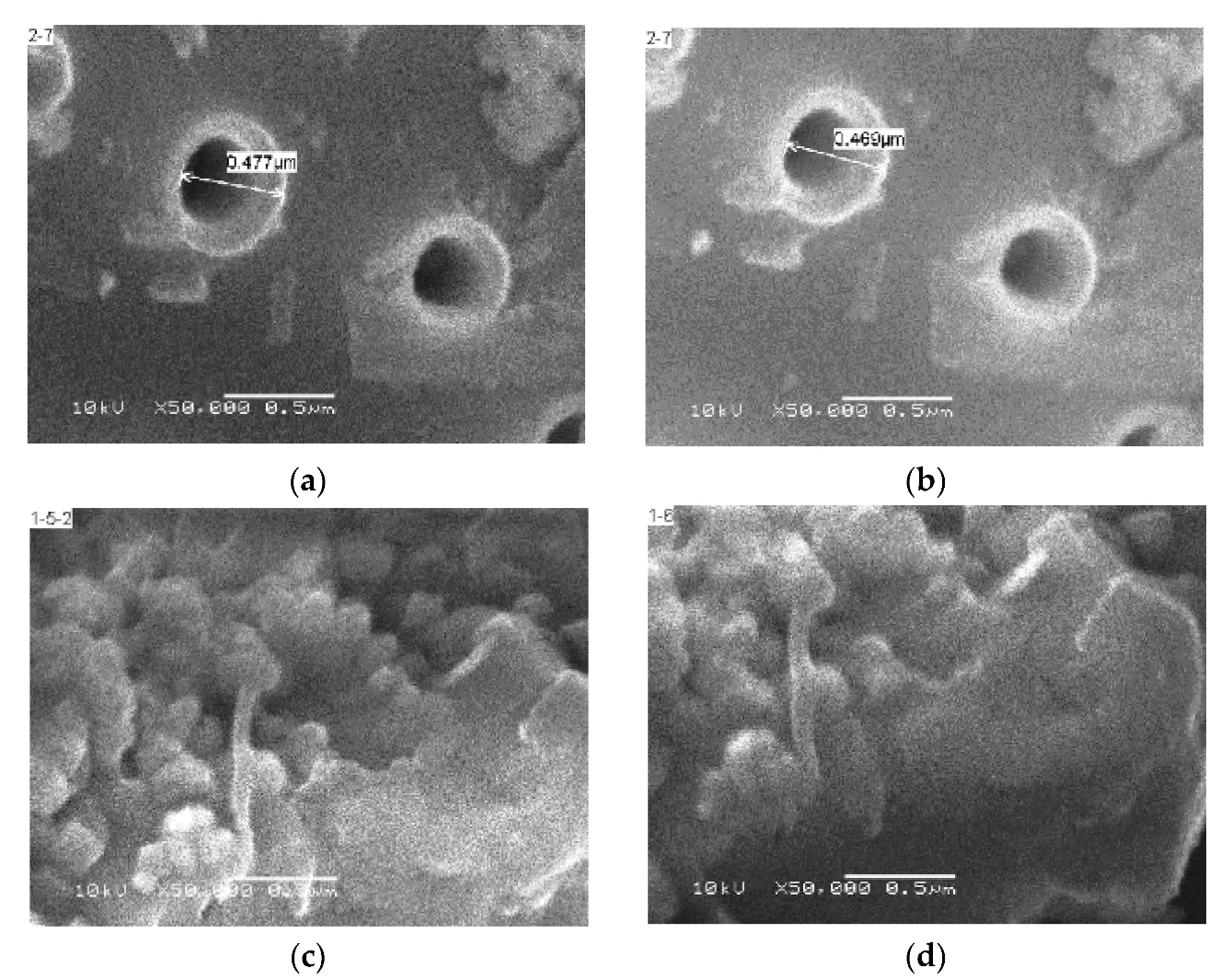
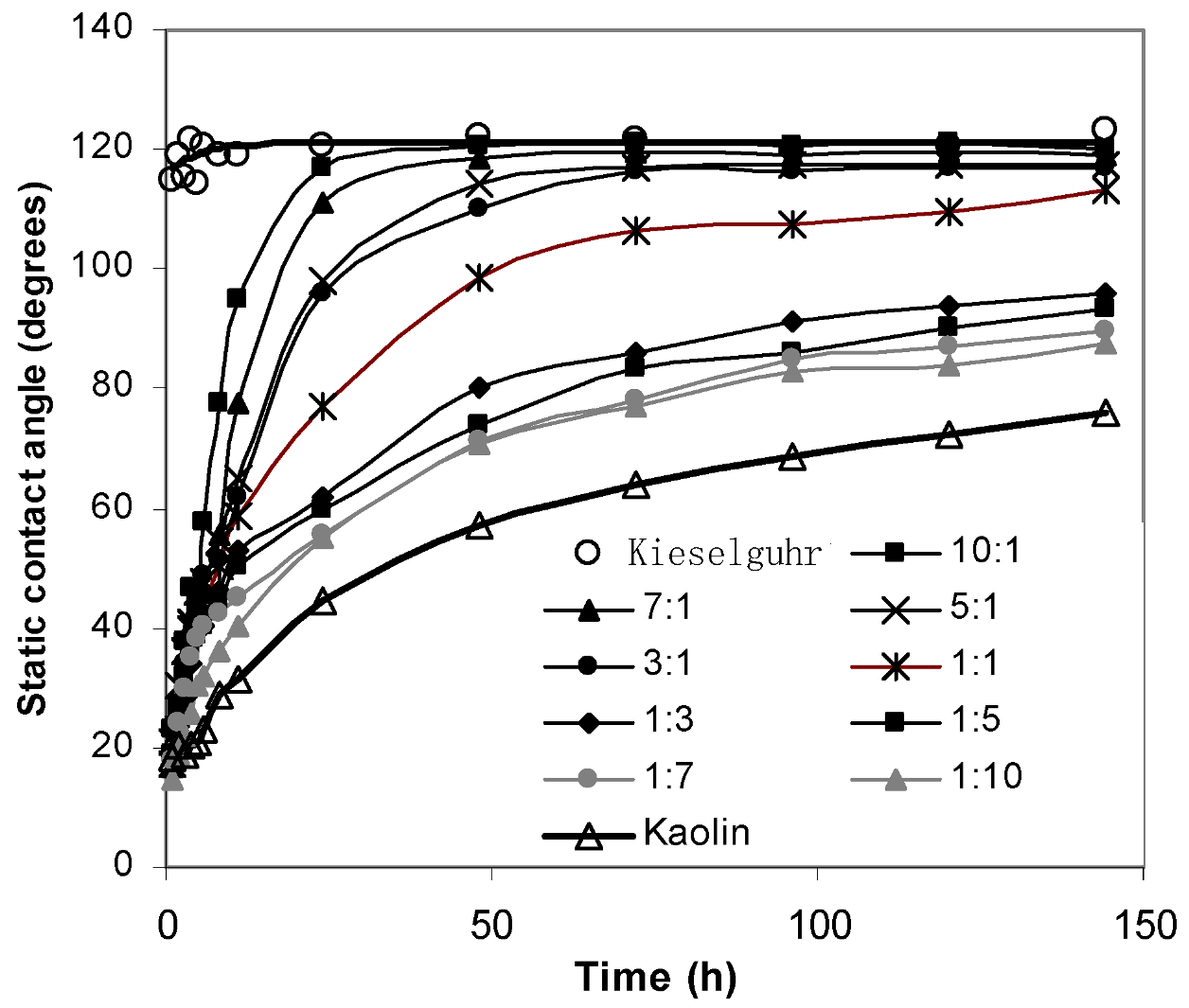

| Chromatographic Separation Time | 8.96 | 10.66 | 12.2 | 13.63 | 14.91 | 16.11 | … | 23.55 | 25.24 |
|---|---|---|---|---|---|---|---|---|---|
| Value n | 8 | 9 | 10 | 11 | 12 | 13 | … | 20 | 21 |
| Material | Kaolin | Kieselguhr |
|---|---|---|
| Specific area (m2/g) | 19 | 14 |
| Total pore volume (mm3/g) | 54 | 37 |
| Average pore (nm) | 11.2 | 10.9 |
Publisher’s Note: MDPI stays neutral with regard to jurisdictional claims in published maps and institutional affiliations. |
© 2022 by the authors. Licensee MDPI, Basel, Switzerland. This article is an open access article distributed under the terms and conditions of the Creative Commons Attribution (CC BY) license (https://creativecommons.org/licenses/by/4.0/).
Share and Cite
Meng, X.; Peng, G.; Niu, K.; Wang, X.; Mei, H.; Wang, L. Characteristics of Small-Molecule Migration of Silicone Rubber Insulator in Electrical Power Systems. Polymers 2022, 14, 2519. https://doi.org/10.3390/polym14132519
Meng X, Peng G, Niu K, Wang X, Mei H, Wang L. Characteristics of Small-Molecule Migration of Silicone Rubber Insulator in Electrical Power Systems. Polymers. 2022; 14(13):2519. https://doi.org/10.3390/polym14132519
Chicago/Turabian StyleMeng, Xiaobo, Gongmao Peng, Kang Niu, Xiaogang Wang, Hongwei Mei, and Liming Wang. 2022. "Characteristics of Small-Molecule Migration of Silicone Rubber Insulator in Electrical Power Systems" Polymers 14, no. 13: 2519. https://doi.org/10.3390/polym14132519






